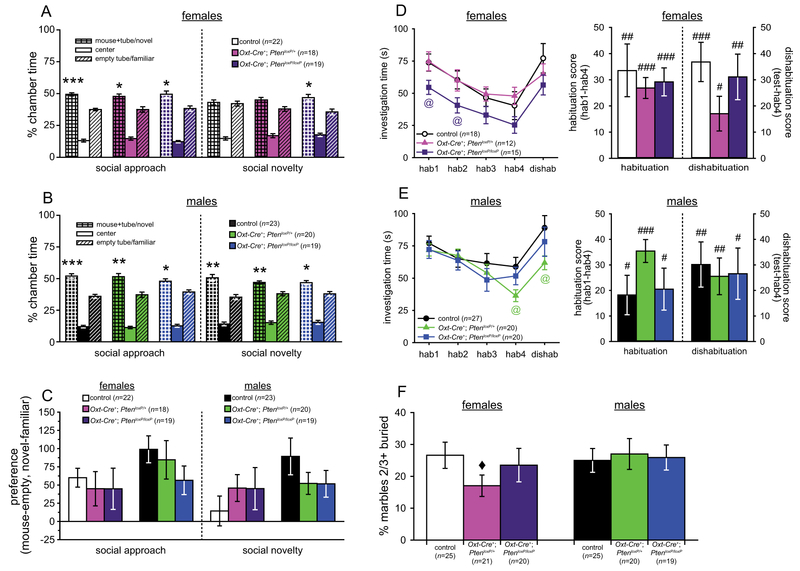Figure 1.
Results of social approach, social recognition, and repetitive behavior tests in Oxt-Cre+; PtenloxP mice. (A–C) Time spent in each chamber (A,B) and chamber preference (C) during the three-chamber social approach and social novelty in control (n = 22), Oxt-Cre+; PtenloxP/+ (n = 18), and Oxt-Cre+; PtenloxP/loxP (n = 19) female mice (A,C) and in control (n = 23), Oxt-Cre+; PtenloxP/+ (n = 20), and Oxt-Cre+; PtenloxP/loxP (n = 19) male mice (B,C). (D,E) Investigation of the stimulus mouse in the social recognition assay across trials, and habituation and dishabituation, in control (n = 18), Oxt-Cre+; PtenloxP/+ (n = 12), and Oxt-Cre+; PtenloxP/loxP (n = 15) female mice (D) and in control (n = 27), Oxt-Cre+; PtenloxP/+ (n = 20), and Oxt-Cre+; PtenloxP/loxP (n = 20) male mice (E). (F) Percentage of marbles at least ⅔ buried after 30 min by control (n = 25), Oxt-Cre+; PtenloxP/+ (n = 21), and Oxt-Cre+; PtenloxP/loxP (n = 20) females and control (n = 25), Oxt-Cre+; PtenloxP/+ (n = 20), and Oxt-Cre+; PtenloxP/loxP (n = 19) males. Significant difference between the mouse chamber and the object chamber or between the novel and familiar mouse chambers: *P < 0.05, **P < 0.01, ***P < 0.001. Significant difference between controls and Oxt-Cre+; PtenloxP/loxP females (D) or between controls and Oxt-Cre+; PtenloxP/+ males (E): @ P < 0.05. Significant habituation or dishabituation: #P < 0.05, ##P < 0.01, ###P < 0.001. Significant difference between controls and Oxt-Cre+; PtenloxP/+ females: ◆ P < 0.05.

